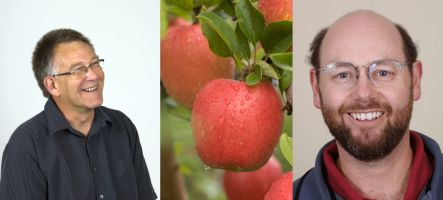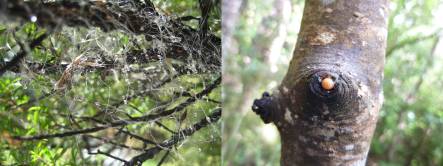Our Changing World for Thursday 29 October 2009
Apple Flavour and Aroma

(image: Plant and Food Research)
Daryl Rowan (above left) and Martin Hunt (above right) from Plant and Food Research are looking at the different flavours and aromas of apples. By measuring the headspace of various apples with gas chromatography-mass spectrometry they are identifying the flavour correlations in apples and helping breeders produce new apple varieties with novel characteristics quickly and cheaply.
They are also working closely with Sue Gardiner from Plant and Food Research, who last week explained how molecular markers can be used to screen for particular characteristics in fruit and plants.
DNA and Medieval Manuscripts
Chris Howe is a plant biochemist at Cambridge University. His research usually focuses on chloroplasts, and their evolution, but a chance conversation at a dinner party has led to an interesting collaboration with literary scholars who study medieval manuscripts. As he describes it 'there are striking parallels between how mutations accumulate in DNA sequences as they evolve, and how changes were incorporated into manuscripts when they were copied by scribes in the days before printing. In a novel interdisciplinary collaboration with manuscript scholars around the world, we are applying the techniques of molecular evolutionary biology to the analysis of a range of texts from the Bible to Chaucer's Canterbury Tales. We are also interested in trying to recover DNA from the parchment that texts were written on.' Alison Ballance spoke with Chris Howe when he was in New Zealand earlier this year at the Bioed Darwin conference.
X-Ray Tomography
Mark Le Gros and his boss, Carolyn Larabell, from the National Center for X-ray Tomography in the USA, have together successfully built a new biological imaging microscope on a beamline at the Advanced Light Source - a synchrotron in Berkeley, California.
Ruth Beran met with them while they were in New Zealand recently, and found out how x-ray tomography works and how it can be used to show the insides of small biological structures in 3D.
Microbes in Honeydew Scale Insects

Many honeydew droplets (image: Mike Taylor) and Coelostomidia zealandica scale insect with its hard outer case removed (image: Manpreet Dhami)
Last week on Our Changing World the University of Auckland's Jacqueline Beggs talked about honeydew and its ecological role in New Zealand forests. This week we stay with the honeydew theme, looking at the work that some of her School of Biological Science colleagues are doing at a microbial level.
Very few animals are capable of feeding exclusively on sugar-rich phloem sap, and microbiologist Mike Taylor and PhD student Manpreet Dhami suspect that symbiotic, or helpful, microbes in the scale insect's gut are the key. Manpreet Dhami's doctoral research is seeking to identify which microbes occur in New Zealand Coelostomatidae scale insects, and to elucidate their roles.